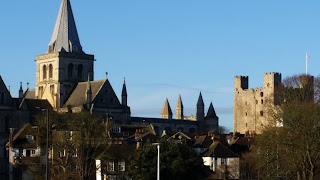Please note that this news blog is no longer updated. All news stories are now added to the Saint Jude website, here.
Wednesday, 3 July 2019
Friday, 8 March 2019
International Women's Day - 2019
Today is International Women's Day (8 March), which is a global day celebrating the social, economic, cultural and political achievements of women.
At the Shrine of Saint Jude, we have some beautiful icons of just a few of the great female Carmelite Saints, as well as various images of Our Lady of Mount Carmel, our mother and sister.
Read about these women, below..
Our Lady of Mount Carmel
The 1995 Constitutions of the Carmelite Friars summarise the importance of Mary in Carmelite spirituality today:
"Mary, overshadowed by the Spirit of God, is the Virgin of a new heart, who gave a human face to the Word made flesh. She is the Virgin of wise and contemplative listening who kept and pondered in her heart the events and the words of the Lord. She is the faithful disciple of wisdom, who sought Jesus - God’s Wisdom - and allowed herself to be formed and moulded by his Spirit, so that in faith she might be conformed to his ways and choices. Thus enlightened, Mary is presented to us as one able to read “the great wonders” which God accomplished in her for the salvation of the humble and of the poor.
Mary was not only the Mother of Our Lord; she also became his perfect disciple, the woman of faith. She followed Jesus, walking with the disciples, sharing their demanding and wearisome journey - a journey which required, above all, fraternal love and mutual service.
Mary brings the good news of salvation to all men and women. She is the woman who built relationships, not only within the inner circle of Jesus’ disciples, but, beyond that, with the people: with Elizabeth, with the bride and bridegroom in Cana, with the other women, and with Jesus’ “brothers”.
Carmelites see in the Virgin Mary, Mother of God and archetype of the Church, the perfect image of all that they want and hope to be. For this reason, Carmelites have always thought of Mary as the Patron of the Order, its Mother and Splendour; she is constantly before their eyes and in their hearts as “the Virgin Most Pure.” Looking to her, and living in spiritual intimacy with her, we learn to stand before God, and with one another, as the Lord’s brothers. Mary lives among us, as mother and sister, attentive to our needs; along with us she waits and hopes, suffers and rejoices."
Read more, here.
In the outer shrine area is a beautiful stained glass window of Mary and the Christ Child with the Holy Spirit. The window was executed by the artist, Richard Joseph King.
The serpent behind is seen as a reference to domination over evil. The serpent and the crescent shape of half moon just visible at the bottom right of the window signify Mary's Immaculate Conception. King was interested in the close relationship of Mary and Christ. The importance of the Holy Spirit is shown in the circular shape of the wings of the dove surrounding the heads of Mary and Christ and the rays which come down from heaven. The red cross against the white background in Christ's halo is a reference to his cross and resurrection. The cross and M seen in the front of the Christ Child are symbols of Mary and Christ.
In the Shrine chapel, the triple light at the back of it depicts Our Lady of Mount Carmel (with the Scapular in her hand) and the Christ-Child with a scapular and dove, with attendant angels on a rainbow. The rainbow imagery here refers to the Old Testament story of Noah in the Book of Genesis. The dove seen above the hands of the Christ Child, could again refer to the dove bringing the olive leaf to Noah, but Christ is also seen as the bringer of peace. Read more, here.
On the side walls of the Shrine chapel are the icons of Carmelite saints.
Blessed Frances D'Amboise
One of the icons is of Blessed Frances D'Amboise, who was born in 1427, probably at Thouars, France. At fifteen years of age, she was married to Peter II, Duke of Brittany and crowned with him in the cathedral at Rennes in 1450. She was widowed in 1457 and, not wanting a second marriage, she turned towards religious life. For this purpose, she built a Carmel for sisters at Bondon in 1463 following the advice of Blessed John Soreth, Prior General of the Carmelites.
Saint Teresa Benedicta of the Cross
The second icon is of Saint Teresa Benedicta of the Cross (Edith Stein), Carmelite nun, martyr, and patron of Europe.
Edith Stein was born to a Jewish family at Breslau on 12th October 1891. Through her passionate study of philosophy she searched after truth and found it in reading the autobiography of St. Teresa of Jesus. In 1922 she was baptised and in 1933 she entered the monastery of Discalced Carmelite nuns in Cologne where she took the name Teresa Benedicta of the Cross. During the Second World War Edith was sheltered from the Nazi persecution of Jews at the Carmel in Echt, Holland. Because of her refusal to deny her Jewish heritage or abandon her sister who was sheltering in the same Carmel, Edith was deported, gassed and cremated at Auschwitz concentration camp on 9th August 1942 and died a martyr for the Christian faith after having offered her holocaust for the people of Israel. A woman of singular intelligence and learning, she left behind a large body of writing notable for its doctrinal richness and profound spirituality. She was beatified by Pope John Paul II at Cologne on 1st May 1987, and canonised by him in 1998. In 1999 she was declared one of the six patron saints of Europe.
We pray for all Carmelite women today and in the past. Thank you.
Amen.
Celebrate Our Lady and get a prayer card, here.
Text taken from the province and Shrine websites
_____________________
Wednesday, 23 January 2019
Sponsored Walk - 2018/2019
"The miracle of life is not flying through the air or walking upon water, but walking upon the earth." (Old Chinese saying)
 |
| Tower Bridge near the Tower of London |
From 20 - 22 January, Mr Matthew Betts, Development Manager at the Shrine, walked from Westminster Abbey in London to Rochester Cathedral in Kent on a belated sponsored walk. The walk is to raise funds for the Order of Carmelites for their important work in the UK and abroad.
If you would like to sponsor Matt, please visit our page, here.
Matt followed the old pilgrimage route as outlined in the recent works of Rev John N Merrill who sets out an excellent path from London via Gravesend to Rochester. It is a pilgrimage route full of history, wonder and beauty. Matt was also very lucky, as although it was cold, it did not rain! Rain always makes it much harder to walk!
Matt started at Westminster Abbey. The Abbey has been the coronation church since 1066, and is the final resting place of seventeen monarchs. The church was begun by Henry III in 1245 and it is one of the most important Gothic buildings in the country, and has the medieval shrine of an Anglo-Saxon saint at its heart, Saint Edward the Confessor. The walk from here is full of history: Matt passed 10 Downing Street; the Cenotaph; before arriving at Trafalgar Square. Afterwards, Matt continued down the Strand, and passed the impressive St Mary le Strand church and the RAF church, Saint Clements Danes (not always RAF, Matt's 17/18th century ancestors worshipped here).
 |
| St Mary le Strand Church |
 |
| Saint Paul's Cathedral |
..and then kept walking along the river until he reached Southwark Cathedral (built in 1106). Matt then kept walking along the river to see views of Tower Bridge and the Tower of London until much later, reaching Greenwich. This is not the last time, the Thames will be seen.
On the route from Greenwich to Gravesend, there are some wonderful sites to see, including the view from the Old Observatory (see below); All Saints Church, Blackheath; and a particular favourite, Christ Church in Bexleyheath. At Christ Church, there were originally stained-glass windows depicting six apostles (though not Jude) and the intention had been to add the other six. However, and unfortunately, money ran out, and the six that had been added were destroyed in bombing during World War 2. It is a beautiful church and it is a good place to stop.
 |
| View of Greenwich |
This towpath follows the railway for a long time and is stunning countryside. The Thames and Medway Canal is a disused canal and was originally some 11 km (6.8 mi) long and cut across the neck of the Hoo peninsula, linking the River Thames at Gravesend with the River Medway at Strood.
 |
| The canal |
 |
| The railway alongside, which is crossed eventually |
Matt then arrived at Saint Mary's Church in Church Street (see below). This church dates from the 14th Century and was near a Priory of Benedictine Nuns. The Priory was one of the first to be dissolved under King Henry VIII in 1521.
After the village of Church Street, Matt walked the last few miles to Rochester. As he walked the hill to Strood, a final view of the Thames can be seen, soon it will be the river Medway!
 |
| The River Thames in the background |
This is very beautiful countryside - even in January - as can be seen in the photos below.
Finally, Matt reached Rochester by crossing the bridge from Strood. Rochester is at the lowest bridging point of the River Medway and is about 30 miles (though not when walking!) from London.
Rochester was for many years a favourite of Charles Dickens, who owned nearby Gads Hill Place, Higham, basing many of his novels on the area. The Diocese of Rochester, the second oldest in England, is centred on Rochester Cathedral and was responsible for the founding of a school, now The King's School in 604 AD, which is recognised as being the second oldest continuously running school in the world. Rochester Castle, built by Bishop Gundulf of Rochester, has one of the best preserved keeps in either England or France, and during the First Barons' War (1215–1217) in King John's reign, baronial forces captured the castle from Archbishop Stephen Langton and held it against the king, who then besieged it.
It is a very interesting town to wander around, especially as the walk was finally complete.
Thank you to all that sponsored Matt. If you still want to, please visit the page, here.
_____________________
Tuesday, 15 January 2019
Stamps - Thank you
For the third year in a row, and thanks to all those people who write to us, we were able to send many postal stamps to another charity to help them in their work. We have recently received a letter from the charity KICKS COUNT thanking the Shrine for all the stamps we donated just before Christmas.
_____________________
Subscribe to:
Comments (Atom)
















